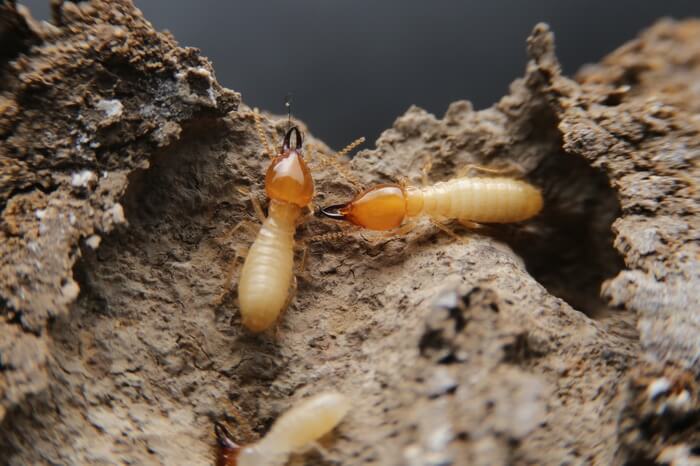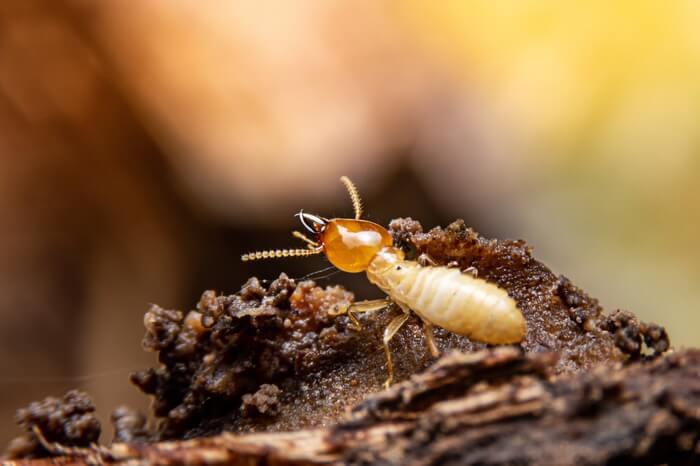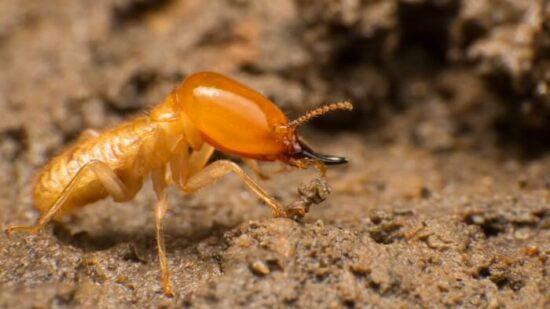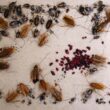If you’ve ever wondered, “Do termites make noise?” then you’re not alone! These pests are feared by many homeowners, and it’s only natural to wonder if sounds you hear at night are made by termites.
This guide will cover all of the possible termite noises you can hear in your home, and what they mean. Being able to recognize these sounds can give you an edge when it comes to protecting your house from these pesky insects!
Table of contents
Do Termites Make Noise?
Termites are tiny insects that have a knack for invading your home unnoticed. In most cases, it’s not until severe structural damage occurs that homeowners detect their presence.
All that said, there are ways to detect these pests as they chew their way through your walls and floors. Believe it or not, termites do make noise (and you can hear them). The sounds they produce are subtle and difficult to hear. But in the right conditions, their activity can become jarring enough to make any discerning homeowner sit up and take notice.
Sounds Termites Make
A solitary termite isn’t going to make much noise. However, these pests operate in massive numbers. Mature colonies can be a million termites strong!
Large groups of termites can produce a few different sounds and noises. Here are the most common.
1. Head-Banging
Ever hear a random rattle sound out of nowhere? You may mistake it for the sound of crinkling paper or larger pests scurrying behind your walls.
In many cases, this distinct termite noise is actually the sound of these insects banging their heads against the wall! Head-banging behavior is a unique defense mechanism that termites use to alert the entire colony of potential danger, and it’s one of the most audible signs of termites.
Soldier termites are responsible for this alert system. Soldiers have more giant heads than traditional worker termites. While they don’t excavate tunnels, these termites are sporting massive mandibles. The claw-like mouth is the perfect weapon against other bugs that may threaten the colony.

When soldiers detect trouble, they’ll start to bash their heads against any nearby walls. It doesn’t have to be the walls of your home. In most cases, they’ll beat their heads against the sides of an excavated tunnel or a mud tube.
As other soldier termites detect the sound, they’ll start to head-bang as well. Before you know it, every soldier in the vicinity is producing noise. By this point, the alert may become audible to those with good hearing.
Quick Tip: Interestingly enough, termites are deaf. As a result, they can’t hear the noises they produce (you can hear this sound better than they can). Instead, they rely on the vibrations! The subtle vibrations ring through the tunnel and let every termite know that trouble is ahead.
2. Wing-Fluttering
Around the spring mating season, you might hear what sounds like a thousand tiny wings fluttering around. Flying termites typically emerge from the nest after the last winter freeze. Temperatures warm up, giving the termites a chance to mate and establish a colony elsewhere.
Swarming events can be pretty intimidating to watch. Thousands of flying termites create visible clouds in the sky as they try to mate.
The good news is that swarms are brief. Most occur in the late evening. As a result, most people don’t even realize they’re happening.
However, you may hear the sound of these termites as they settle in your home.
Swarming termites gravitate towards light. They’ll usually land near windowsills, bright light fixtures, or even ventilation slots in the attic. When this happens, you can sometimes hear the wings hitting the wood.
If you have thin and easy-to-access walls, the termites might even make their way into an available cavity. When this happens, you might hear these termites in your walls since their sound will amplify and ring through your home.
Quick Tip: The fluttering sound doesn’t last long, so you’ll need to act fast to locate the termites. Once these pests find a suitable place to set up shop, they’ll drop their wings. You may find a pile of dried-up wings near the source of the initial fluttering noise.
3. Rustling & Clicking
In some instances, you can even hear termites in action.
The soft rustling and clicking could be the sound of termites chewing and tunneling through wood nearby. These insects chew through wood fibers and destroy the structural integrity of wall framing, subfloors, ceiling rafters, and more. They tend to follow the grain as they tunnel their way through, but that doesn’t do much to dampen the noise.
As the termites chew to excavate tunnels, they destroy wood cellulose. That’s the rattling and clicking you hear.
Quick Tip: After the termites have done their worst, the affected wood will sound different when you tap it. This noise isn’t produced by termites directly. Instead, it’s a byproduct of their destructive nature.
Tapping on wood that termites previously destroyed will create a noticeably hollow sound. The tap will reverberate a bit, which is a stark contrast to a healthy and dense piece of wood.
How Easy Is It For You To Hear Them?
Don’t expect termites to make a ton of audible noise. Generally, these pests are silent and fly under the radar.
While your home may seem quiet, there are likely several sources of ambient noise in the vicinity. Whether it’s the low hum of your refrigerator, the sound of your air conditioner blowing, or audio from the television in the next room, there are usually far too many things that drown out the faint noise of termites tunneling their way through your home.

It’s only when things get super quiet that you might start to hear them. You also have to have a pretty decent sense of hearing to detect them (congrats).
As mentioned earlier, you’re more likely to hear larger colonies of termites than small ones. Bigger groups will make a lot more collective noise that you could potentially hear when things get quiet.
Can You Hear Termites Eating?
Head-banging is the most prevalent noise you’ll hear. However, you can sometimes hear these tiny pests eating and chewing.
It’s a subtle sound that’s usually covered up by ambient noise. But in the right conditions, you might detect the slow and methodical movement of termites as they chew through wood.
The chewing sounds like soft clicking and rattling. It can be pretty alarming, but the sound is a combination of two things. It’s the constant movement of the termite’s capable mandibles as they gnaw at the wood and the sound of wood cellulose breaking down.
Do They Make Noise At Night Or During The Day?
Contrary to popular belief, termites don’t have a set schedule. The destructive pests work around the clock to wreak havoc on your home.
Believe it or not, but termites are rare organisms that don’t require sleep to stay healthy. They can keep chewing day and night regardless of how tired they are!
Many homeowners claim that they only hear termites at night. Some varieties are indeed more active as the sun starts to set. Drywall termites tend to be more energetic at night when they’re around lights. Meanwhile, Formosan swarmers will search for a mate around dusk.
However, the soldiers and workers continue their quest to eat and tunnel at all hours of the day. The reason why you’re more likely to hear termite noises at night is that things tend to get quieter around the home.
Fewer things are going on, leaving a window of quiet where even the tiniest noises sound amplified. You’re more likely to hear termites as you settle into bed for the night and all other ambient noise ceases.
Conclusion
Termites make noise, but it’s hard to hear them most of the time. That’s why it’s always smart to keep an eye out for other signs of an infestation.
Let us know if you have any useful audio or video footage of termite sounds. We would love to share it in this guide!


